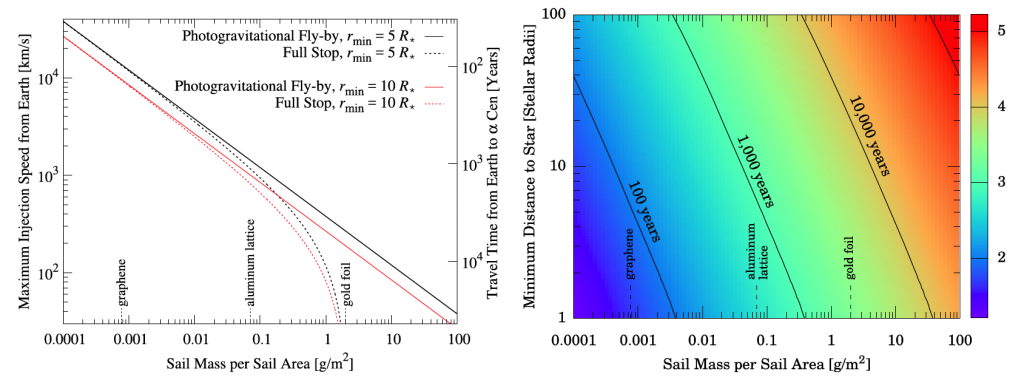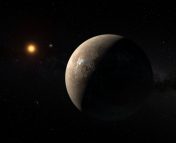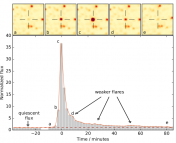Title: Deceleration of High-velocity Interstellar Photon Sails into Bound Orbits at α Centauri
Authors: René Heller and Michael Hippke
First Author’s Institution: Max Planck Institute for Solar System Research
Status: Published in the Astrophysical Journal Letters, open access
In August 2016, astronomers announced the discovery of a potentially Earth-like planet in orbit around Proxima Centauri, the Sun’s nearest stellar companion. With this announcement, we humans—the eager, sometimes greedy explorers that we are—are already itching to scout out this far-off planet. Where we can’t go we send robotic surrogates, their instruments more sensitive to photons than human eyes, more sensitive to particles than human hands. These stand-ins stare unblinking at the glare of the Sun. They celebrate lonely birthdays coated in the red dust of Mars. And given enough time, they leave the solar system behind. Time is precious to us, though, and the distance traveled by Voyagers 1 and 2 in their 39-year lifespan is just 0.05% of the distance to Proxima Centauri; traveling at the same rate as Voyager 1, it would take over 75,000 years to reach the Sun’s nearest companion. Humans are far too impatient to wait that long. How can we get there faster?
One proposed way is by using photon sails: ultralight, ultra-reflective mirrors that are propelled by radiation pressure. One plan to do just this is the Breakthrough Starshot initiative, which involves using high-power lasers to accelerate miniature spacecraft to 20% the speed of light. The resultant travel time—just over 20 years—is mercifully short, but even assuming the spacecraft survives the interstellar journey, it will pass through the α Centauri system in just a few hours, placing huge demands on the imaging system in order to capture any meaningful data.
In this paper, the authors expand upon the photon sail idea in a way that minimizes the travel time to the α Centauri system while maximizing the potential to do meaningful science once there. They integrate the stellar radiation pressure along the photon sail’s path and use a modified N-body code to show that the combined gravitational pull and radiation pressure of the stars in the α Centauri system can be used to steer a photon sail through the system—possibly even into a stable orbit around Proxima Centauri.
The potential trajectories calculated using the simulation are shown in Figure 1 below.

Figure 1. Left: Four types of trajectories around α Centauri A. Right: Single sample trajectory showing how the orientation of the sail (short black lines) changes as it passes the star. Image from Figure 2 of this paper.
In Figure 1, type II and III trajectories are stable orbits around α Centauri A, from which the spacecraft could make observations before continuing on to α Centauri B and Proxima Centauri (or even do an about-face and return to Earth!). In principle, the spacecraft could even be steered into orbit around Proxima b—a vantage point that would yield almost unimaginable science results.
Before we get too starry-eyed about the prospect of snapping pictures of the closest exoplanet… exactly how long will we have to wait? The total travel time depends strongly on what the sail is made of; Figure 2 shows how the travel time increases with increasing mass per unit area of the sail. If we consider a photon sail crafted from graphene with the entirety of the instruments for science, navigation, and communication weighing in at just 10 grams, it would still need an area of roughly 100,000 square meters—equivalent to nearly 20 football fields. For this sail, it would take ~100 years to get to α Centauri A and another ~50 years to reach Proxima Centauri.

Figure 2. Left: Travel times (on the right hand vertical axis) for photon sails with varying values of mass per unit area. As the mass per unit area increases, the maximum injection speed decreases and the travel time increases. Right: Photon sail travel times as a function of both the mass per unit area of the sail and distance of closest approach to α Centauri. The color bar indicates the log of the travel time in years. As the sail gets closer to the star, the danger of the sail being damaged by high-energy stellar particles increases. Image from Figure 5 from this paper.
This means that the exploration of the α Centauri system via this method—and possibly a habitable planet orbiting Proxima Centauri—is just out of reach of a human lifetime. Do we send our robotic surrogates off to the stars now, so that future humans can see the nearest potentially habitable exoplanet with the electronic eyes we build today? Even if photon sails never make the journey to the α Centauri system, they could still provide speedy transportation to the outer solar system, where plenty of discoveries are waiting to be made.





Trackbacks/Pingbacks